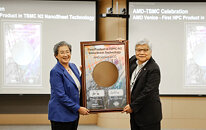- Joined
- Oct 9, 2007
- Messages
- 47,949 (7.37/day)
- Location
- Dublin, Ireland
| System Name | RBMK-1000 |
|---|---|
| Processor | AMD Ryzen 7 5700G |
| Motherboard | Gigabyte B550 AORUS Elite V2 |
| Cooling | DeepCool Gammax L240 V2 |
| Memory | 2x 16GB DDR4-3200 |
| Video Card(s) | Galax RTX 4070 Ti EX |
| Storage | Samsung 990 1TB |
| Display(s) | BenQ 1440p 60 Hz 27-inch |
| Case | Corsair Carbide 100R |
| Audio Device(s) | ASUS SupremeFX S1220A |
| Power Supply | Cooler Master MWE Gold 650W |
| Mouse | ASUS ROG Strix Impact |
| Keyboard | Gamdias Hermes E2 |
| Software | Windows 11 Pro |
In an interview with Bloomberg, AMD CEO Dr Lisa Su revealed that the company's chips manufactured at the U.S. based fab of TSMC will cost anywhere between 5% to 20% more than the ones TSMC makes back home in Taiwan, but assured that the added cost and supply-chain resilience would make the price-hike worth the effort. Su alluded to the lack of supply-chain resilience being sorely felt by the tech industry during the COVID-19 pandemic years, causing significant second order effects across the world economy.
TSMC has a manufacturing facility in Arizona, but its most advanced node is 4 nm EUV, referred to internally as the N4 family of foundry nodes by TSMC. AMD makes various CPUs, GPUs, FPGAs, and other devices on the TSMC N4P node, but the company is transitioning to the new TSMC N2 (2 nm Nanosheet) node, starting with its next-generation "Zen 6" CPU family. It is widely expected that while the CCDs of "Zen 6" based Ryzen desktop and EPYC server processors are based on N2, the company will introduce new-generation I/O dies for both its client and server processors that will be built on TSMC N4P, advancing from the current TSMC N6.

View at TechPowerUp Main Site | Source
TSMC has a manufacturing facility in Arizona, but its most advanced node is 4 nm EUV, referred to internally as the N4 family of foundry nodes by TSMC. AMD makes various CPUs, GPUs, FPGAs, and other devices on the TSMC N4P node, but the company is transitioning to the new TSMC N2 (2 nm Nanosheet) node, starting with its next-generation "Zen 6" CPU family. It is widely expected that while the CCDs of "Zen 6" based Ryzen desktop and EPYC server processors are based on N2, the company will introduce new-generation I/O dies for both its client and server processors that will be built on TSMC N4P, advancing from the current TSMC N6.

View at TechPowerUp Main Site | Source









